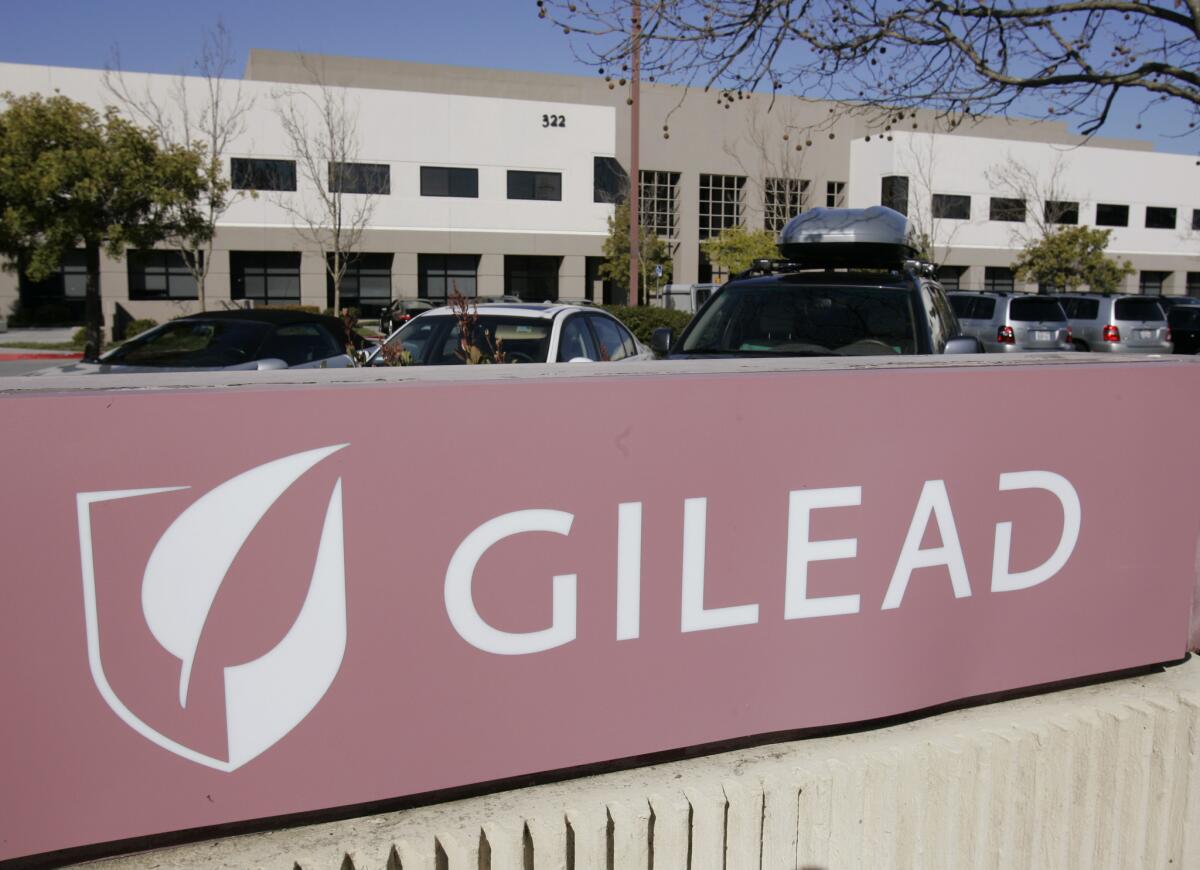Column: Is that $100,000 hepatitis treatment worth the price? Yes, but can society afford it?

Gilead Sciences’ wonder drugs for hepatitis C are at the center of the debate over drug prices.
- Share via
The stratospheric prices of new drugs are sometimes rationalized by the savings they’ll generate down the road — cure a condition now, even at high expense, and you’ll reap the benefits by keeping the patients in better health and off the operating table.
A team of researchers from UC San Francisco and the Institute for Clinical and Economic Review, a nonprofit research organization in Boston, has subjected the new crop of hepatitis C drugs to just such a real-world calculation. According to their findings, published in the journal JAMA Internal Medicine, the drugs, which can cost nearly $100,000 for a 12-week cure, pass the test — they’re priced reasonably in terms of their cost per added year of life and good health for almost all patients.
The new ... therapies offer potentially huge individual and societal benefits but at a large cost.
— Kahn et al., Journal of the American Medical Assn.
But that just sharpens the debate on drug prices. A drug can be cost-effective, yet unaffordable. Many are so expensive that despite their benefits for patients, in the aggregate, they’re budget-busters for government programs or insurance carriers. As a result, many patients who would gain those additional healthy years may not gain access to treatment at all.
The new hepatitis C treatments include two from Gilead Sciences: Sovaldi, which costs $84,000 per 12-week treatment, and Harvoni, which was priced at nearly $100,000 when it was introduced about a year ago. Both drugs have become symbols of out-of-control pharmaceutical prices. But they’re also extremely effective at curing the infection, with minimal side effects.
“This is an incredibly effective treatment,” says Jeffrey A. Tice, a member of the UC San Francisco team that studied the drugs’ cost in conjunction with the Institute for Clinical and Economic Review. “By the usual metric, it’s cost effective. But the problem is that there are so many people who are infected, that it breaks the bank of a healthcare organization to treat a substantial percentage of patients in any one year.”
At current list prices, the study found, the treatment of 100% of America’s more than 2 million hepatitis C sufferers could cost more than $100 billion over five years, even after accounting for offsetting gains reaped from avoiding medical problems caused by untreated infection.
That points to one of the glaring flaws in the American system of healthcare: Payment for treatments come from a fragmented sector that includes individual insurers, big employers, Medicare, Medicaid and others. Particular payers may cover patients for only a few years before they move to another insurer or program. As a result, the entity paying the big bill for any enrollee’s hepatitis C treatment may just be saving money for someone else.
That’s why there’s still heavy resistance from insurers to the high price of the hepatitis C drugs. In the words of Richard Mayhew, the ace insurance blogger at the Balloon Juice blog, “It is not cost effective for most insurers to pay $80,000 for gains that will occur when the patient is no longer covered by that insurer.”
That means the U.S. is going to have to come up with new ways of deciding when a drug is too costly to prescribe, or new ways to push the price of new drugs lower, or both.
How can a treatment be cost-effective, yet unaffordable? It’s all in what you’re measuring. The traditional metric for cost-effectiveness is price per quality-adjusted life year, or QALY: How long will a given treatment extend a patient’s life on average, factoring in the quality of life for the patient.
The cost-per-QALY is commonly used in Britain and other countries to help government healthcare authorities judge whether to pay for a new therapy. Americans don’t like to think of healthcare in such calculating terms — in fact, Congress has forbidden Medicare and Medicaid to base coverage decisions on cost factors.
But QALY-based cost-effectiveness is used quietly in the private sector to help judge new treatments. As a rule of thumb, in the U.S., a treatment is thought to be cost-effective if it costs less than $150,000 per QALY compared with an alternative treatment, and highly cost-effective at $50,000.
By that measure, Sovaldi and Harvoni meet the cost-effectiveness standard. Tice and his colleagues calculated that in almost all scenarios, the drugs cost less than $150,000 per QALY compared with the traditional treatment, an interferon-based therapy that caused agonizing side effects.
But what of the total cost? The Institute for Clinical and Economic Review has suggested that the U.S. healthcare economy can absorb a new drug that costs up to $904 million a year more than the previous treatment for a condition. A treatment that costs more should “trigger policy actions to manage affordability,” the institute says — including a federal subsidy for payers, negotiated-price reductions by manufacturers or limiting the medicine to priority patients, such as the most severely affected.
“No matter how you slice it,” the institute’s chief scientific officer, Dan Ollendorf, told me by email, “Harvoni or Sovaldi for Hep C blows the $900 million threshold out of the water.”
The UC San Francisco study estimated 3.2 million people in the U.S. are infected with the hepatitis C virus, which many contracted from transfusions of contaminated blood between 1945 and 1965, or from sharing infected needles. Many don’t even know they’re carriers because the disease is often asymptomatic in its earliest stages and may never progress to the point where it causes serious illness. The researchers figured that about 2.83 million people would be aware of their hepatitis infection and seek treatment by 2019.
Treating even half of those with the most common form of the disease, they calculated, would cost $53 billion at the drugs’ list price. Some of the cost would be offset by averting the medical consequences of advanced hepatitis C, including cirrhosis, liver cancer, the need for liver transplants and death. But that would come to a few billion dollars in offsets, not nearly enough to negate the cost of treatment.
With medical science entering a new era of hugely expensive drug therapies, the urgency is rising to figure out how to assess the benefits of new drugs and how to pay for them. Getting the policy wrong means depriving millions of people of miracle cures because they don’t have the money or their insurers refuse to pay.
“We haven’t sorted out how to deal with drug prices in general,” Tice says. “That’s the debate we’re having as a society.”
Keep up to date with Michael Hiltzik. Follow @hiltzikm on Twitter, see our Facebook page, or email [email protected].
More to Read
Inside the business of entertainment
The Wide Shot brings you news, analysis and insights on everything from streaming wars to production — and what it all means for the future.
You may occasionally receive promotional content from the Los Angeles Times.











